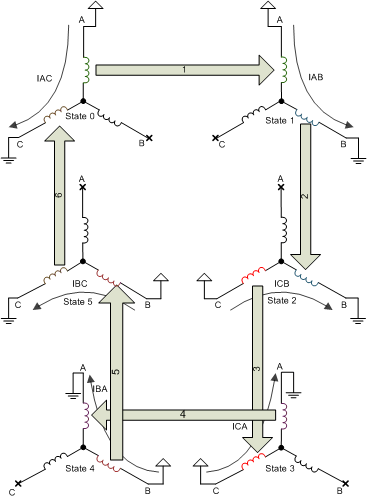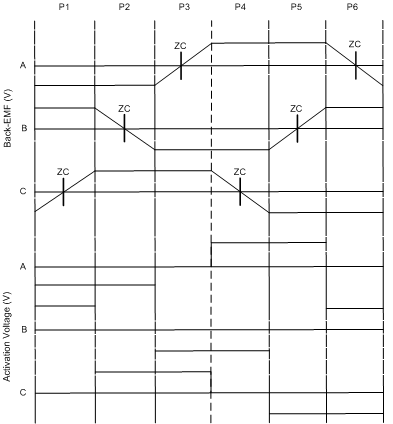SLVA654B June 2014 – March 2019 DRV8301 , DRV8301-Q1 , DRV8302 , DRV8303 , DRV8307 , DRV8308 , DRV8312 , DRV8323R , DRV8332
-
Hardware design considerations for an efficient vacuum cleaner using a BLDC motor
- Trademarks
- 1 Suction Principle
- 2 Brushless DC Motors (BLDC)
- 3 Microcontrollers
- 4 Gate Driver and MOSFETs
- 5 Isolation
- 6 Power Management (6 to 60-V DC Power Supply)
- 7 CAP and QEP interfaces
- 8 Enhanced Controller Area Network (eCAN)
- 9 High-Resolution and Synchronized ADCs
- 10 DRV8323R
- 11 Feedback Stage
- 12 Conclusion
- 13 About the Author
- 14 References
- Revision History
2.2.1.2 Sensorless Control
The disadvantages of Hall Effect sensors listed in Section 2.2.1.1 are compensated for by using sensorless control. One of the ways of overcoming the disadvantages of Hall Effect sensors is by using back-EMF sensing. This method works because one coil is always de-energized according to the working principle. The rotor position is then detected using the back-EMF signature of that coil. This signature is the Zero crossing of that back-EMF signal.
The BLDC motor is a permanent magnet motor with a trapezoidal back-EMF, as opposed to the sinusoidal back-EMF found in a permanent-magnet synchronous motor. Figure 4 shows the trapezoidal waveforms of a three-phase BLDC. In every commutation step, one phase winding is connected to a positive supply voltage, one phase winding is connected to a negative supply voltage, and one phase is floating. The zero crossings of phase back EMFs are indicated by ZC. The zero crossing occurs directly in the middle of two commutations. At a constant speed, or a slowly varying speed, the time period from one commutation to zero-crossing and the time period from zero-crossing to the next commutation are equal which is used as basis for the implementation of sensorless-commutation control. The floating phase, where the zero crossing must be detected, changes for every commutation step. One ADC channel for each phase winding is needed to detect zero crossings.
The sensorless commutation method has challenges during startup or at very low speeds.A common method is to use excite the winding with a random start up commutation. A table of inter-commutation delays for the first few commutations is stored in flash. This sequence is executed without attention to the back-EMF feedback. The control is then passed over to the sensorless commutation controller.

